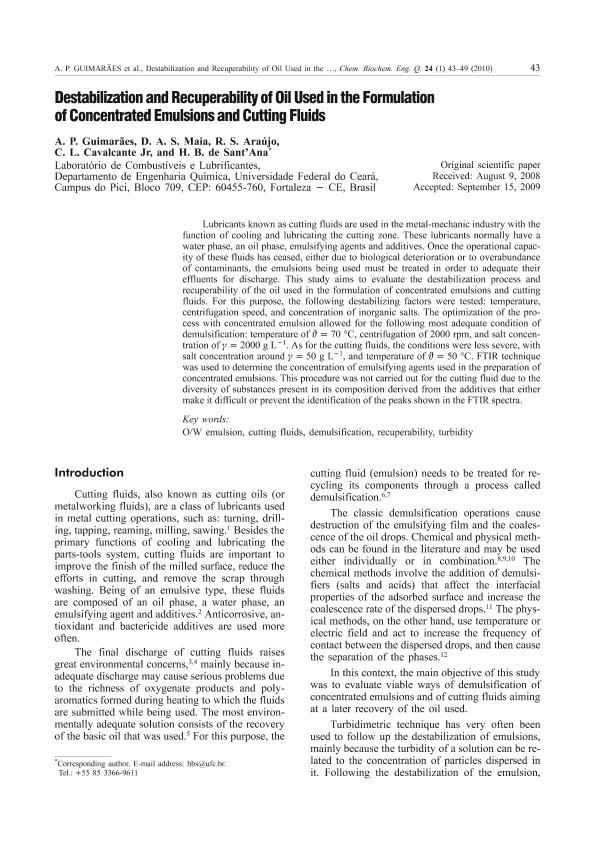Artículo
Destabilization and recuperability of oil used in the formulation of concentrated emulsions and cutting fluids
Guimarães, A. P.; Soares Maia, Debora Aline ; Araújo, R. S.; Cavalcante Jr., C. L.; Sant' Ana, H. B. de
; Araújo, R. S.; Cavalcante Jr., C. L.; Sant' Ana, H. B. de
 ; Araújo, R. S.; Cavalcante Jr., C. L.; Sant' Ana, H. B. de
; Araújo, R. S.; Cavalcante Jr., C. L.; Sant' Ana, H. B. de
Fecha de publicación:
01/2010
Editorial:
Croatian Soc Chemical Engineering Technology
Revista:
Chemical And Biochemical Engineering Quarterly
ISSN:
0352-9568
Idioma:
Inglés
Tipo de recurso:
Artículo publicado
Clasificación temática:
Resumen
Lubricants known as cutting fluids are used in the metal-mechanic industry with the function of cooling and lubricating the cutting zone. These lubricants normally have a water phase, an oil phase, emulsifying agents and additives. Once the operational capacity of these fluids has ceased, either due to biological deterioration or to overabundance of contaminants, the emulsions being used must be treated in order to adequate their effluents for discharge. This study aims to evaluate the destabilization process and recuperability of the oil used in the formulation of concentrated emulsions and cutting fluids. For this purpose, the following destabilizing factors were tested: temperature, centrifugation speed, and concentration of inorganic salts. The optimization of the process with concentrated emulsion allowed for the following most adequate condition of demulsification: temperature of 70 °C, centrifugation of 2000 rpm, and salt concentration<br />of 2000 g /L. As for the cutting fluids, the conditions were less severe, with salt concentration around 50 g/L, and temperature of 50 °C. FTIR technique was used to determine the concentration of emulsifying agents used in the preparation of concentrated emulsions. This procedure was not carried out for the cutting fluid due to the diversity of substances present in its composition derived from the additives that either make it difficult or prevent the identification of the peaks shown in the FTIR spectra.
Palabras clave:
O/W Emulsion
,
Cutting Fluids
,
Demulsification
,
Recuperability
Archivos asociados
Licencia
Identificadores
Colecciones
Articulos(INFAP)
Articulos de INST. DE FISICA APLICADA "DR. JORGE ANDRES ZGRABLICH"
Articulos de INST. DE FISICA APLICADA "DR. JORGE ANDRES ZGRABLICH"
Citación
Guimarães, A. P.; Soares Maia, Debora Aline; Araújo, R. S.; Cavalcante Jr., C. L.; Sant' Ana, H. B. de; Destabilization and recuperability of oil used in the formulation of concentrated emulsions and cutting fluids; Croatian Soc Chemical Engineering Technology; Chemical And Biochemical Engineering Quarterly; 24; 1; 1-2010; 43-49
Compartir



